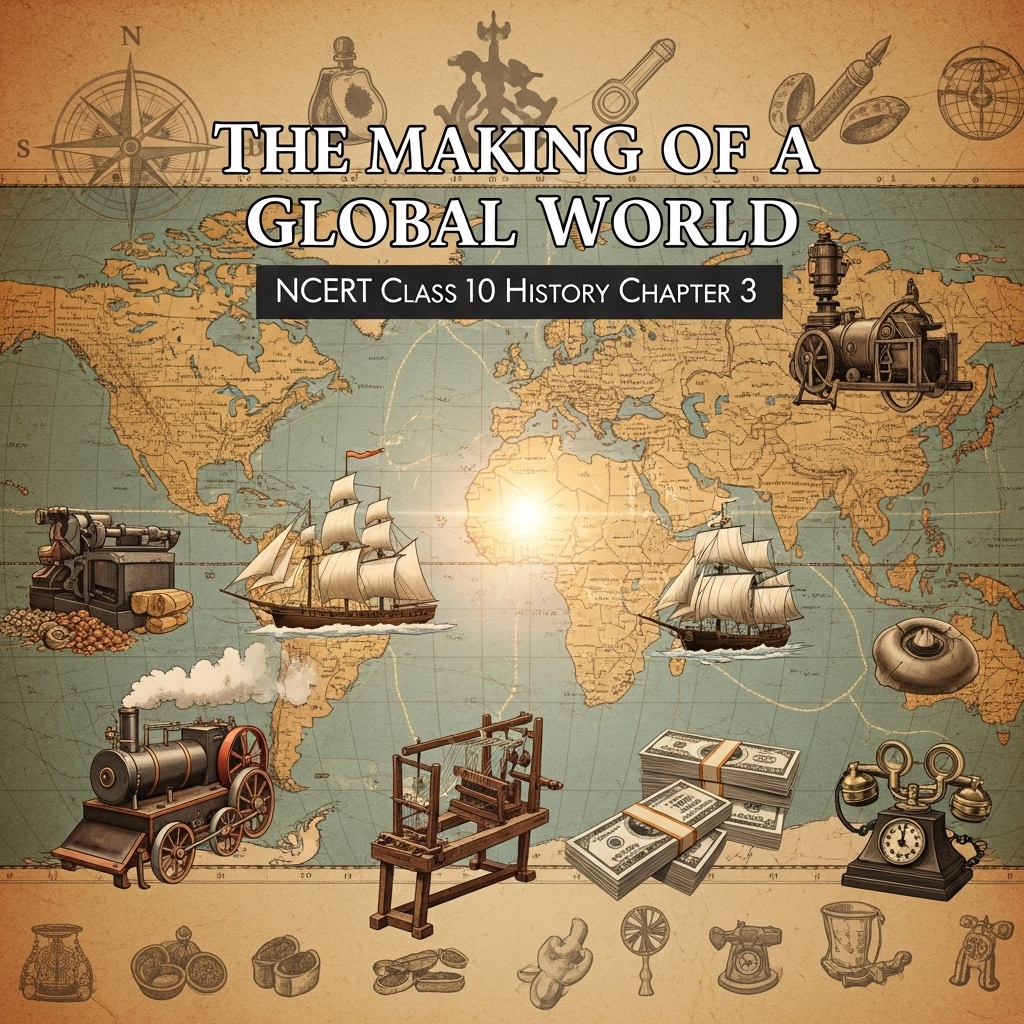Complete Solutions and Summary of The Making of a Global World – NCERT Class 10, History, Chapter 3 – Summary, Questions, Answers, Extra Questions
Detailed summary and explanation of Chapter 3 'The Making of a Global World' covering the phases and history of globalization, ancient and pre-modern trade, migration, colonialism, indentured labour, emergence of a world economy, technological developments, world wars, the Great Depression, Bretton Woods institutions, economic crisis, decolonisation, global transformations, and Indian perspectives—with all question answers and extra questions from NCERT Class X History.
Updated: 1 month ago
Categories: NCERT, Class X, History, Summary, Extra Questions, Globalisation, Colonialism, Trade, Migration, World Economy, Economic History, World Wars, Bretton Woods, Decolonisation, Chapter 3

The Making of a Global World
Chapter 3: History - Complete Study Guide | NCERT Class 10 Notes & Questions 2025
Comprehensive Chapter Summary - The Making of a Global World Class 10 NCERT
Overview
- Chapter Purpose: Explores globalisation's long history beyond last 50 years, through trade, migration, capital, ideas. Human societies interlinked via travellers, traders, priests, pilgrims carrying goods, money, values, skills, inventions, germs/diseases. From 3000 BCE Indus-West Asia trade; cowries from Maldives to China/East Africa. Disease spread from 7th century, clear link by 13th. Fig. 1: Ship on Goa memorial stone, 10th CE, shows oceanic trade. Key Insight: Global interconnectedness phases; world 'shrank' in 1500s. Discuss: World 'shrank' meaning - closer via sea routes to Asia/America.
- Expanded Relevance 2025: Links to modern globalisation, colonialism's dark side, technology's role. Update: Parallels with current trade, migration, pandemics.
- Exam Tip: Focus on flows (trade, labour, capital); use figures for visuals; understand pre-modern to 19th century shifts.
- Broader Implications: Globalisation brought prosperity but also exploitation, disease, loss of freedoms.
1. The Pre-modern World
- 1.1 Silk Routes Link the World: Pre-modern vibrant trade/cultural links. 'Silk routes' for West-bound Chinese silk; land/sea routes linking Asia-Europe-North Africa pre-Christian Era to 15th CE. Chinese pottery, Indian/Southeast Asian textiles/spices travelled; gold/silver from Europe to Asia. Fig. 2: Silk route in Chinese cave painting, 8th CE. Fig. 3: Merchants Venice-Orient, 15th CE from Marco Polo. Trade with cultural exchange: Christian missionaries, Muslim preachers via routes; Buddhism from India spread through intersections.
- 1.2 Food Travels: Spaghetti and Potato: Long-distance cultural exchange examples. Noodles from China to spaghetti (perhaps via Arab traders to 5th CE Sicily); similar in India/Japan. Potatoes, soya, groundnuts, maize, tomatoes, chillies, sweet potatoes introduced to Europe/Asia post-Columbus' Americas discovery (use 'America' for North/South/Caribbean). From American Indians; transformed diets, e.g., Europe's poor ate better post-potato; Ireland's peasants dependent, mid-1840s famine killed 1M, 2M emigrated. Fig. 4: Irish Potato Famine, 1849.
- 1.3 Conquest, Disease and Trade: World shrank 16th CE post-European sea routes to Asia/America. Indian Ocean trade bustling pre-Europeans; subcontinent central, Europeans expanded/redirected flows. America isolated millions years; post-discovery, lands/crops/minerals transformed trade. Silver from Peru/Mexico financed Europe-Asia trade; El Dorado legends. Portuguese/Spanish conquest mid-16th CE; not just firepower but germs like smallpox - no immunity for American Indians, decimated communities. Box 1: 'Biological' warfare? John Winthorp 1634 on smallpox as God's blessing. Guns bought/captured but diseases unbeatable. Europe: poverty, hunger, diseases, religious conflicts common; thousands fled to America. 18th CE plantations by African slaves grew cotton/sugar for Europe. China/India richest till 18th CE, pre-eminent Asian trade; China restricted overseas 15th CE, retreated; Americas' rise shifted trade centre to Europe. Fig. 5: Slaves for sale, New Orleans, 1851. New word: Dissenter - refuses established beliefs/practices.
2. The Nineteenth Century (1815-1914)
- Overview: World changed profoundly; economic/political/social/cultural/technological factors interacted, transformed societies/external relations. Three flows: trade (goods like cloth/wheat), labour (migration for employment), capital (investments). Interwoven, affected lives deeply; labour often restricted more than goods/capital. Helps understand 19th CE world economy.
- 2.1 A World Economy Takes Shape: Changing food production/consumption in industrial Europe. Traditional self-sufficiency meant lower standards/conflict. Britain: Late 18th CE population growth increased food demand; urban/industrial growth pushed prices. Landed groups pressured Corn Laws restricting imports. Industrialists/urban dwellers forced abolition. Post-scrapping, cheaper imports; British agriculture couldn't compete, lands uncultivated, unemployment, city flock/overseas migration. Activity: Flow chart - Britain's food import decision to increased migration America/Australia. Food prices fell, consumption/incomes rose mid-19th CE; imports from Eastern Europe/Russia/America/Australia. Lands cleared, railways/ports built, settlements; capital from London, labour from short-supply areas. 50M emigrated Europe to America/Australia; global 150M migrated. Fig. 6: Emigrant ship US, 1869. Fig. 7: Irish emigrants board, 1874. Activity: Imagine as Irish agricultural worker in America - why came, earning living. By 1890 global agricultural economy: food from afar, by recent migrants on ex-forest farms, via purpose-built railways/ships manned by low-paid southern Europe/Asia/Africa/Caribbean workers. Similar for cotton (British mills), rubber. 1820-1914 trade multiplied 25-40 times; 60% primary products (wheat/cotton/coal/minerals). Closer home: West Punjab Canal Colonies - British canals transformed semi-desert to wheat/cotton export lands, settled by Punjab peasants.
- 2.2 Role of Technology: Railways, steamships, telegraph transformed 19th CE; results of social/political/economic factors, e.g., colonisation stimulated transport investments. Meat trade example: Till 1870s live animals shipped America-Europe, space-inefficient, died/lost weight/unfit. Meat expensive luxury. Refrigerated ships enabled slaughter at source (America/Australia/New Zealand), frozen transport to Europe; reduced costs, lowered prices. Poor added meat/butter/eggs; varied diet, better conditions, social peace, imperialism support.
- 2.3 Late Nineteenth-Century Colonialism: Trade/markets expanded, prosperity; darker side - loss freedoms/livelihoods in colonised societies via world economy integration. Fig. 8: Smithfield Club Cattle Show, 1851. Fig. 9: Meat loaded on ship, 1878.
SEO Note: Why This Guide?
Top-ranked for 'The Making of a Global World Class 10 notes 2025'—free, with 60 Q&A from PDF, quizzes. Integrates historical insights.
Key Themes
- Global Interconnections: Pre-modern to modern shifts.
- Flows Details: Trade/labour/capital; impacts. Figures: Visual aids.
- Colonialism Links: Exploitation, diseases.
- Critical Thinking: Globalisation pros/cons; technology's role.
Cases for Exams
Potato famine migration; refrigerated ships meat trade; Corn Laws abolition.
Exercises Summary
- Focus: Expanded to 60 Q&A from PDF: 20 short (2M), 20 medium (4M), 20 long (8M) based on NCERT exercises + similar.
- Project Idea: Timeline globalisation; map silk routes.
Group Discussions
No forum posts available.


